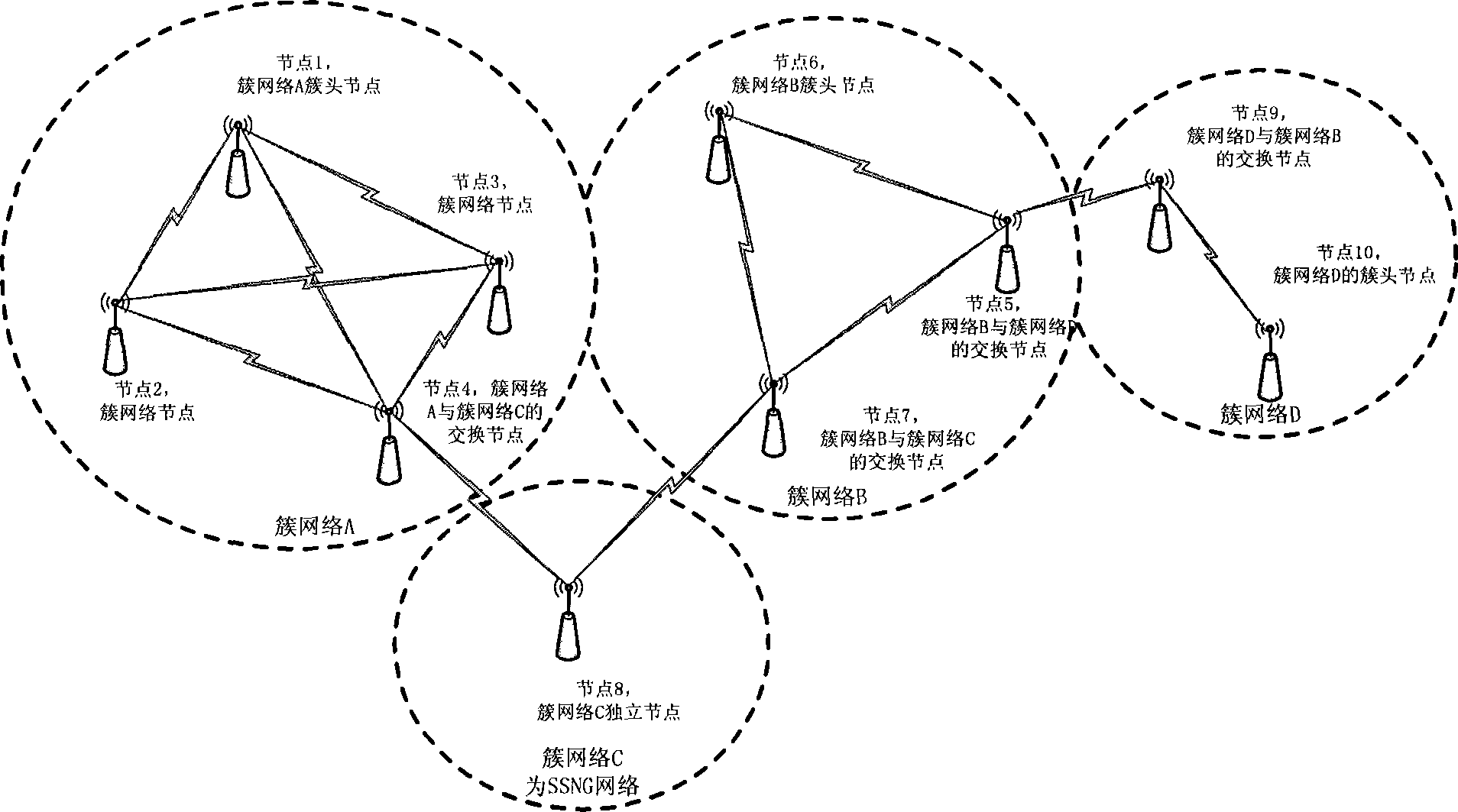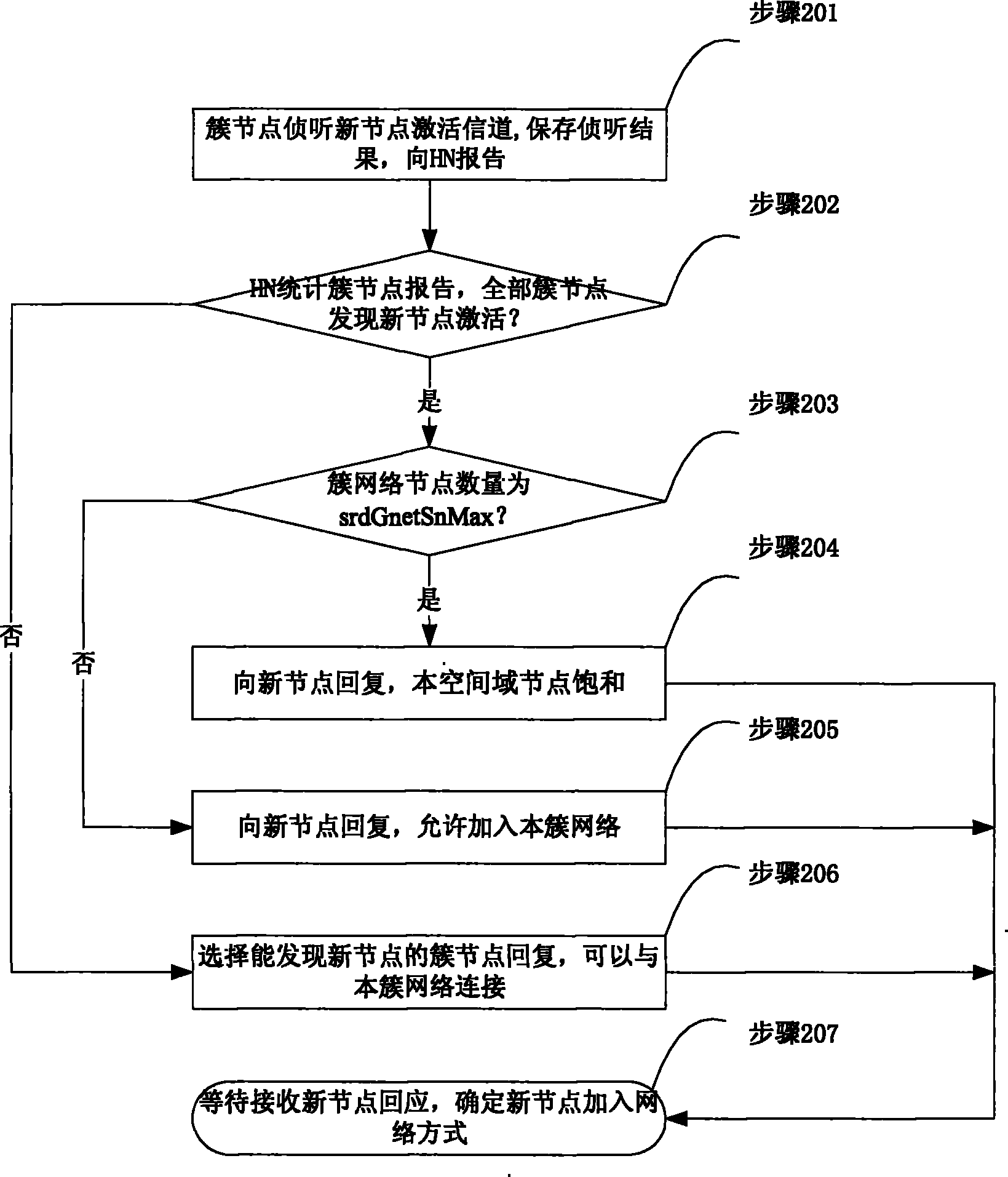Wireless sensor network, establishing method and communication method
A wireless sensor and network technology, applied in data exchange networks, transmission systems, digital transmission systems, etc., can solve the problems of unbalanced data transmission affecting network performance, large data traffic, and packet forwarding data transmission bottlenecks.
- Summary
- Abstract
- Description
- Claims
- Application Information
AI Technical Summary
Problems solved by technology
Method used
Image
Examples
Embodiment 1
[0186] Embodiment 1, a wireless sensor network, as shown in Figure 1,
[0187] The nodes that can be directly connected to each other in the network form a cluster. Each cluster network adopts the principle of energy optimization, and regularly selects a node as the cluster head node. The cluster head node is responsible for confirming the network topology changes of the cluster network, updating and publishing the cluster network communication schedule exchange. Nodes 1, 6, 8, and 10 in the figure are respectively the current cluster head nodes of cluster networks A, B, C, and D.
[0188] The cluster head node selects the node in its cluster network that can connect with the adjacent cluster network as the border switching node of its cluster network. Communication between adjacent cluster networks can only be performed through border switching nodes. As shown in the figure, a node in cluster network A needs to communicate with a node in cluster network C, which can only be...
Embodiment 2
[0197] Embodiment 2, a method for establishing a wireless sensor network.
[0198] As shown in FIG. 2 , in the method for establishing a wireless sensor network, the cluster network processes steps for discovering a new node activation message.
[0199] Step 201 , during the GEC working period, the cluster network node listens to whether there is a new node activation message on the new node activation channel, and records the listening result. When the GIC communication works, the time division multiplexing of the cluster nodes occupies the working channel of the cluster network, and reports to its cluster head node that a new node is activated.
[0200] In step 202, the cluster head node receives reports from other cluster nodes about discovering the activation of new nodes, and checks whether all nodes in the cluster network have discovered the activation information of the new nodes.
[0201] If yes, go to step 203.
[0202] Otherwise, go to step 206 .
[0203] In step ...
Embodiment 3
[0212] Embodiment 3, in a method for establishing a wireless sensor network, the processing steps for a new node to determine the mode of joining a cluster network. As shown in Figure 3 and 4,
[0213] In step 301, after the network node is reset and initialized, a new node joins the network process.
[0214] In step 302, the new node listens to the system predefined new node activation channel (srdSnActiveChannel) and the system backup new node activation channel (srdSnActiveBakChannel) in turn to check whether there is an idle channel.
[0215] If yes, go to step 304.
[0216] Otherwise, go to step 303.
[0217] In step 303, the new node determines that the operation of joining the network cannot be performed at present, and the new node enters a sleep state, wakes up after a system-defined sleep time (srdSnActiveSleep), and executes step 302 again.
[0218] Step 304, the new node marks the currently available new node activation channel, and publishes a new node activati...
PUM
 Login to View More
Login to View More Abstract
Description
Claims
Application Information
 Login to View More
Login to View More - R&D
- Intellectual Property
- Life Sciences
- Materials
- Tech Scout
- Unparalleled Data Quality
- Higher Quality Content
- 60% Fewer Hallucinations
Browse by: Latest US Patents, China's latest patents, Technical Efficacy Thesaurus, Application Domain, Technology Topic, Popular Technical Reports.
© 2025 PatSnap. All rights reserved.Legal|Privacy policy|Modern Slavery Act Transparency Statement|Sitemap|About US| Contact US: help@patsnap.com



